
Bevendean History Project
Ray Bond Memories of StanmerI first
visited Stanmer Park when I started work in 1951. The park had
been taken over by Brighton Corporation and they built public
toilets. One just inside the gate, on the left-hand side was near
the Lower Lodges. Along the track on the right-hand side of the
entrance there are changing rooms for the football pitches which were
built after the University of Sussex opened. Another toilet block
was built behind the main house, which was for the domestic
servants. Those toilets were built by the end of the year with
the aim of opening the park the following Easter.
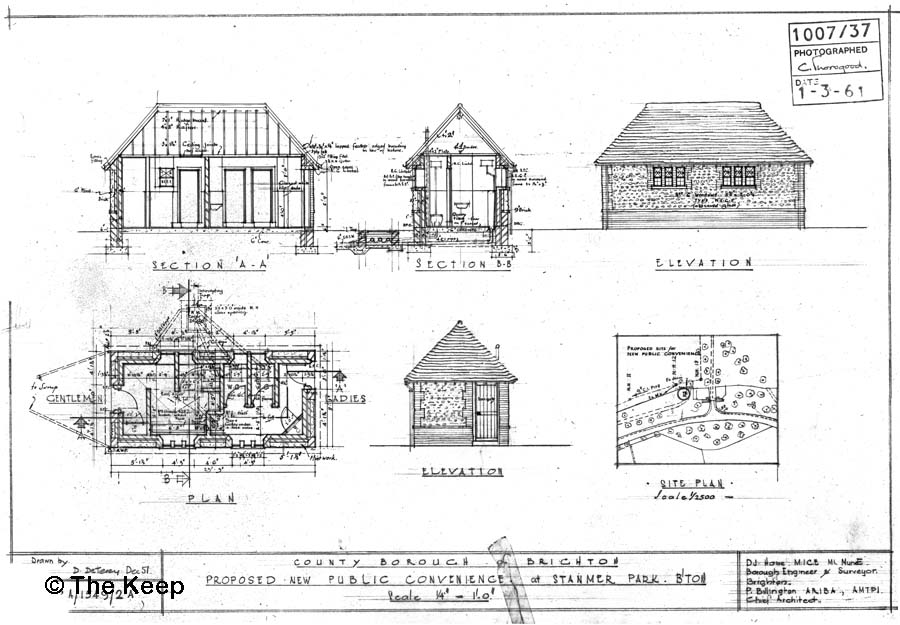
The plans for the toilets just inside the entrance to Stanmer Park. © The Keep. Ref: DB/D/113/1007/37.
We did the rendering inside of them just before Christmas. The plumbers came in to fix the services and the urinals in the gents and we came back to do the step to the urinal and grano floor. On the morning, we arrived we had to cycle through snow; about four six inches had fallen overnight. I can remember cycling up the road with a great deal of difficulty, there was not a footprint in the snow. However, every tree you came to had squirrels’ footprints all around it, searching for their food. I would say that when you got to where the road splits there were still Nissen huts on their bases, that had been used by the Canadians and it was like coming upon a village lost in a Wonderland of snow.
There were not many cars, in those days, but as you got near the top of the road you saw more and more of the village. A sight, that has always stuck in my mind. Not a soul around, you went up to the house and then round behind where the toilets were being built. You had the ladies and gents. But that sight, with the snow has always stuck in my mind and you didn't have cameras because they were not very popular in those days. You could not get them just after the war.
This was my introduction to grano. We did not do anything because the temperature was below zero. We put all the form work in and had to come back later. We had a lorry arrive in the afternoon with the material, but the temperature was below freezing. The floor was not done for about four days, until the snow had cleared. That was my introduction to Stanmer Park. A better site I have never seen. I have been associated with it for many years. I played football in it, for the Boys Brigade, when it opened and for Mile Oak. When I played football and I played several games in there and I was referee for several games in there later on. At the lower end where the toilets were, one of the Nissan huts was originally used as a changing room.
Note. Grano is a fine-grained hard-wearing concrete and makes a smooth floor surface.
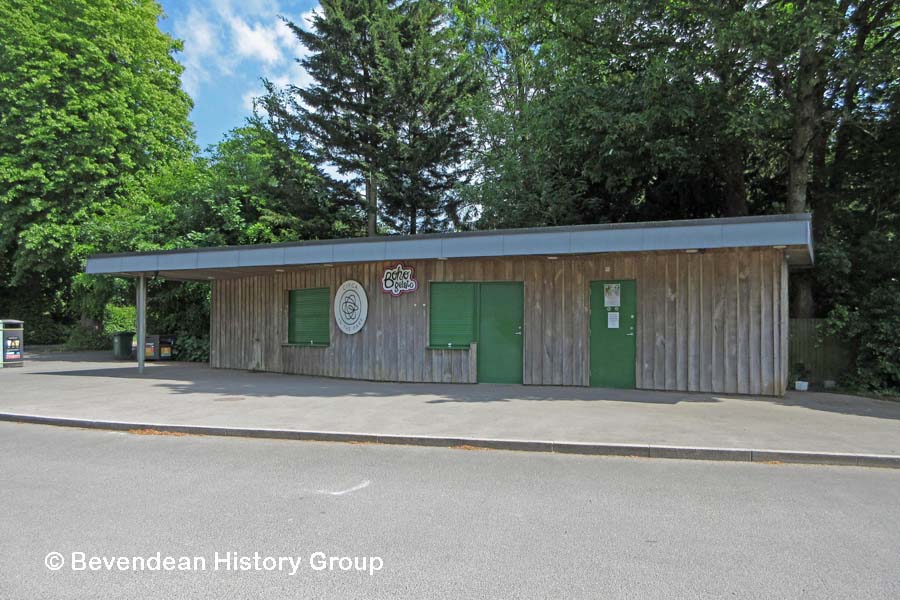
The toilets just inside the entrance have been replace by a small café and toilets above. © Bevendean History Group.
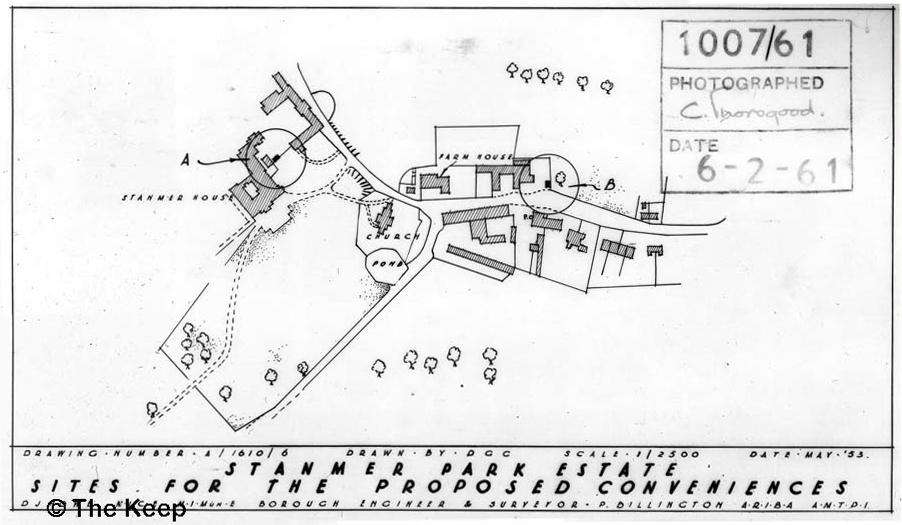
The toilet block built at B is still in use, but a disabled access toilet has been built at the side of the original toilets. © The Keep, Ref: DB/D/113/1007/61.
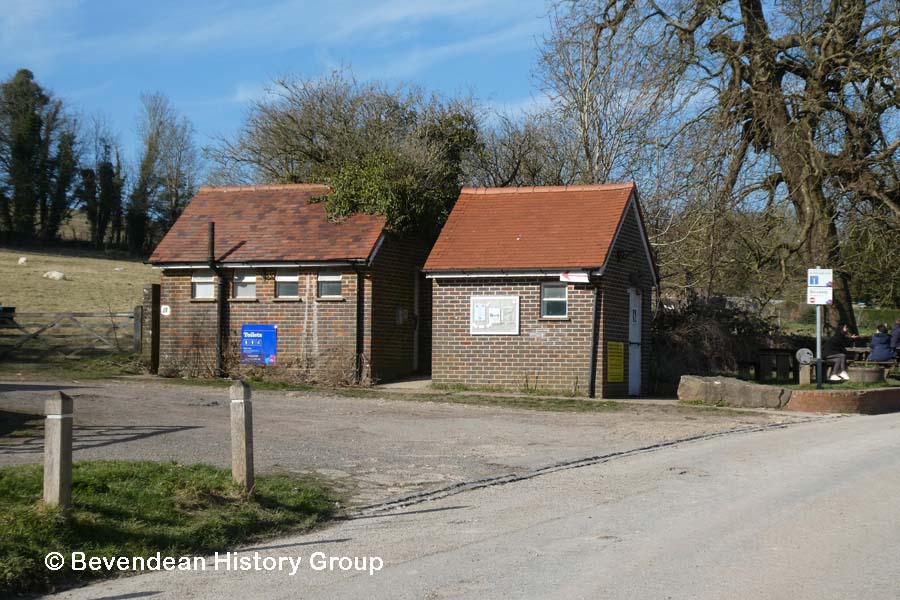
The disabled access toilet built at the side of the original toilets. © Bevendean History Group.
When I left school, I joined Brighton Football Club, which played rugby. They had a first team, an extra first and an 'A' team. The extra first and 'A' team teams used to play rugby in Stammer Park.
We used to come up behind the house to play. We changed in Preston Park where the first team played. We used to get on a coach with the two teams and the officials, then we were driven out to Stanmer Park. We used to go around the house and up into the gardens. There was this field marked out now, which we played rugby on. When the game was finished, we went back to Preston Park for a shower. I forget when that would be, but probably in 1952/1953. Those were my earliest recollections of the park. I think you will find if you check, that Brighton Football Club moved to Withdean Stadium in about 1954. To play their first team and extra first eight matches and they had the second team, then they started playing at Patchdean, I think it is on the estate at Patcham.
Other than that, my recollections for Stanmer Park, are when my children were born in the late sixties, early seventies. We used to visit Stanmer Park quite often and I found a cousin there. My father fell out with his two sisters. I was only introduced to one and got no further than the front step. I was in the park one day and somebody tapped me on the shoulder and said my mother saw you the other day when you were over and said you were my cousin. He worked on the farm and I think he lived in the third house at the farm. Whenever Pat, my wife, and I went to Stanmer Park we went to the café. His wife worked part-time in the cafe and he always used to come down and see us, because it was mostly Sunday afternoon and he was not working on the farm. He must have been there, for five to seven years and then he went elsewhere and l have never seen him since.
The park was part of the private Pelham family estate until it was purchased by Brighton Town Council in 1947. Just after the war you could not go there, because it was all War Department Property as it had been requisitioned during WW2.
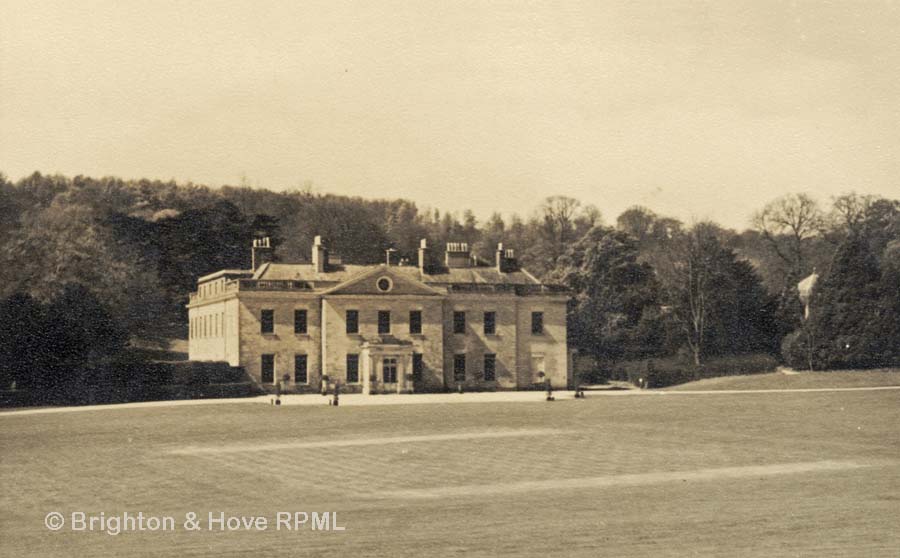
Stanmer House c1930s.
Reference: ha926528. © Royal Pavilion & Museums, Brighton & Hove
After my father was demobbed, we went to Stanmer. We wanted to go to St Mary’s Farm, which is up behind Falmer and the land from there right up to the Lewes Race Course was (War Department) WD property where the Canadians trained. As I understand it, they trained there for the Dieppe raid and then for D-day.
The three of us, went to St Mary’s Farm, when the area was opened up, to pick raspberries. I do not know what year St Mary’s Farm was cleared of WD stuff. The three of us caught the nine o'clock bus out of Brighton, because no buses ran on a Sunday before 9 o'clock, to Falmer and we walked up to St Mary’s farm which still had all the Nissen nuts beside the road and we picked wild Raspberries. We went home with 51 pounds of raspberries and we were sitting at the dinner table at one o'clock the next morning. You did not pick raspberries, you just put the bag on the floor and shook the raspberry canes, and I have never picked so many raspberries in my life.
We went back in August and did same with the blackberries, but you had to pick them, you could not get shake them. And that was when the area was first open to the public.
There were not many buses going from Brighton to Lewes, but I would not like to say how sparse they were, because we did not go that way very often.
There was a bus stop at the bottom of Coldean Lane, where the houses had been built in the 1930s and possibly near the entrance to the park as there were cottages just inside the gates of Stanmer Park. But I think they were all requests stops that you had to wave the bus down if you wanted it to stop. It was not a dual carriageway then; it was just a standard A road and I can remember riding my bike and motorbike up there.
When I was working on the new toilets there was nobody from Stanmer House about. The one thing I always remember from Stanmer house is the weather cock on the roof. The Canadian soldiers had used it for rifle practice and it was full of holes. There was no one living in the house, the back end of it was in a poor state of repair and eventually, it was pulled down. The dilapidation had gone too far and it could not be renovated for any useful purpose. That was some years later.
The tools we used are the same, as I have still got in my house now. I was an apprentice plaster. Fred Homewood was my colleague and the person I was learning from and I worked with Fred for four years, all through my apprenticeship. We did not see a labourer on that day because he could not get there, because there were no buses along the London Road. We ended up putting the rules down. We had to do a step to the gent’s urinal, we fixed the formwork for it. We had to do a bottle Cove all around the walls, so he put the rules in for the floor to do that first. The walls had been rendered before by us at the early date as I said and the lorry turned up. The first lorry had the grano chippings on it and they dropped half behind the house and the other half down at the park entrance. A second lorry carried grano fines and the cement to mix to make the concrete.
When we were building the toilets there was no body about. When we played rugby up there, the gardens were being used as the nursery for the Brighton Town gardens. Brighton in those days had its own gardening section and they did all the gardens themselves. The nursery at Stanmer was used for bringing on the bedding plants to be transferred to the flower beds in the town.
The nursery was evacuated during the war, so there was nobody there doing the gardens during the war, or just after.
After the war they would have been brought back to life to do Brighton gardens, because the town still had them. There was only a small area where they brought on the different plants. On the other side we played rugby, I think I can remember traveling up eight or nine times when I played for the Extra 'A' or the 'A’. Then I got moved to the extra first which played their matches in Preston Park.
I can remember the odd person being there, because being winter time you could not do much in the garden. The workers were probably down in the town, sorting out the gardens in the town getting them ready for transferring the plants to the beds in the town. If you were growing Spring flowers, they would have been planted in the autumn.
As far as I can remember when you drove up the road the gardens were on the left-hand side and the rugby pitch was on the right-hand side.
When the park was first opened to visitors you could not go in the house, because it was in a very, very poor state. You could not go in the garden adjacent to it, because stuff was boarded up and being blown off the house and it was all fenced off. You could go to the Donkey Water pump in the gardens and that had been renovated to a workable standard.
The farm was empty, it was not being used and to be honest from the time we completed the toilets, we did not go back there until our children were a few years old. When we went there in the seventies, I did play football but that was on the lower ends of the park near the main road.
There was evidence of the occupation from when the Canadian troops were there. The Nissen huts were still there. I would not like to say how many at least four or five, if you went in the main entrance - you had a cottage on the east side, which I think is still there. But where the car park stands, is where I park now. There were three or four huts there and there were three or four where the road splits before getting to the house. The Canadians also used the house and they had lots of Nissan huts on the road from behind The Swan up to St Mary’s farm, which is reached from Falmer village.
I was always told that the Canadian troops trained for the Dieppe raid at Stanmer and they also trained for D-Day there. I think you would have to confirm that in other ways, but they were there, that was one of their main bases in the area. They also had a guest house in Brighton, where the Canadians living there would go out to Stanmer and do their training. After the war the area was all fenced off because it had to be cleared of all the live ammunition that was still around.
I cannot remember the park being involved in any festivities at that, not until the university came. It was just a park for the use of the Brighton people. I have photographs of people out there playing from my family. My mate meet his wife out there, pulling her leg when we were out there for a family afternoon.
I used to go out there with the two or three families and we would meet up to have a game of rounder's or something else, or we played football. Mostly on the road up to the main house. You had pitches on the left-hand side and you had two behind the cottage of the entrance and one on the left-hand side.
The road through the Brighton nurseries was closed to the public so I have no idea how large they were.
I have never met any person that lived at Stanmer before the war. I do not think that the people evicted during the war moved back there.
When my children were small, we walked around the park because they always had horses in the fields. We would come out on the Old Ditching Beacon Road, by the farm on top of the hill. I have done that trip many times, but I cannot recall talking to anybody up there.
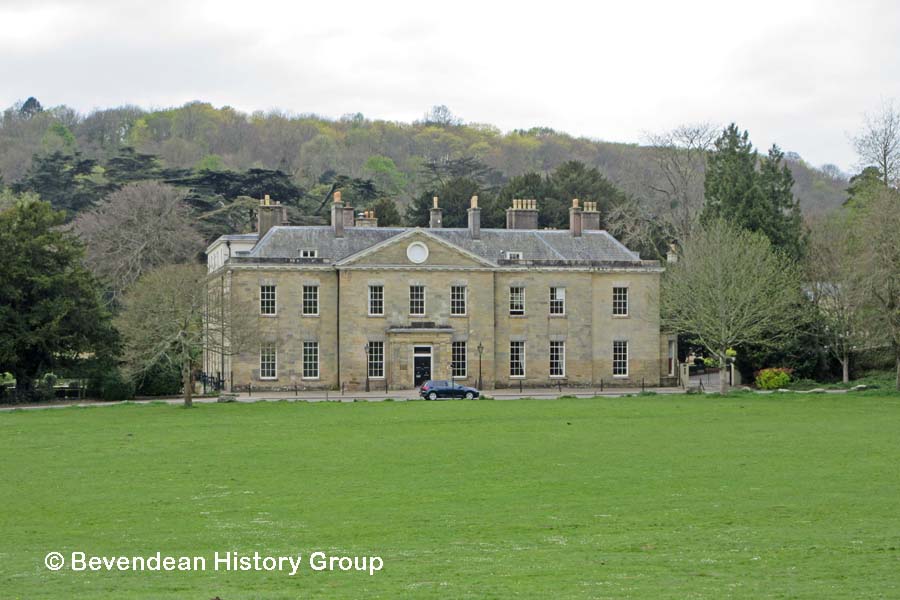
Stanmer House in April 2025. © Bevendean History Group.
A boy aged 13 or 14 climbed into an area that was still fenced off with WD notices and picked up a hand grenade and it blew up and killed him. He had a pet Jackdaw and it was not frightened of people and when the houses started being built, he used to go into the mess room and pinch the bloke sandwiches. They were always chasing it out of the hut. It was there for two or three years. But how long it was between when he died and when the houses were built, I wouldn't like to say.
The boy was not killed in a house; he picked the grenade up off the ground. He had climbed in to the woods and found it.
The houses at the bottom Coldean Lane were built in the 1930s, then further up the road they started building the new council houses and the prefabs but this was in the 1950s.
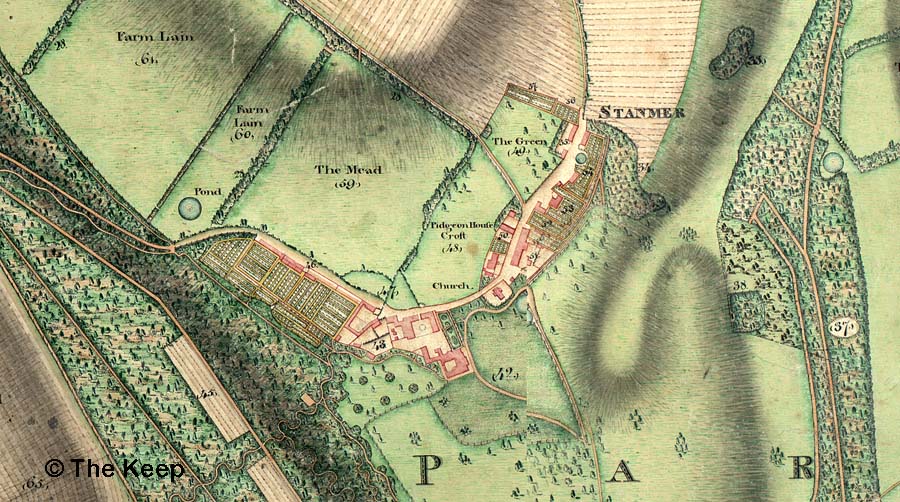
A plan of Stanmer Village drawn by William Figg in 1799 from the Keep Archives. Keep Ref: ACC 3714/4.

The plans for the toilets just inside the entrance to Stanmer Park. © The Keep. Ref: DB/D/113/1007/37.
We did the rendering inside of them just before Christmas. The plumbers came in to fix the services and the urinals in the gents and we came back to do the step to the urinal and grano floor. On the morning, we arrived we had to cycle through snow; about four six inches had fallen overnight. I can remember cycling up the road with a great deal of difficulty, there was not a footprint in the snow. However, every tree you came to had squirrels’ footprints all around it, searching for their food. I would say that when you got to where the road splits there were still Nissen huts on their bases, that had been used by the Canadians and it was like coming upon a village lost in a Wonderland of snow.
There were not many cars, in those days, but as you got near the top of the road you saw more and more of the village. A sight, that has always stuck in my mind. Not a soul around, you went up to the house and then round behind where the toilets were being built. You had the ladies and gents. But that sight, with the snow has always stuck in my mind and you didn't have cameras because they were not very popular in those days. You could not get them just after the war.
This was my introduction to grano. We did not do anything because the temperature was below zero. We put all the form work in and had to come back later. We had a lorry arrive in the afternoon with the material, but the temperature was below freezing. The floor was not done for about four days, until the snow had cleared. That was my introduction to Stanmer Park. A better site I have never seen. I have been associated with it for many years. I played football in it, for the Boys Brigade, when it opened and for Mile Oak. When I played football and I played several games in there and I was referee for several games in there later on. At the lower end where the toilets were, one of the Nissan huts was originally used as a changing room.
Note. Grano is a fine-grained hard-wearing concrete and makes a smooth floor surface.

The toilets just inside the entrance have been replace by a small café and toilets above. © Bevendean History Group.

The toilet block built at B is still in use, but a disabled access toilet has been built at the side of the original toilets. © The Keep, Ref: DB/D/113/1007/61.

The disabled access toilet built at the side of the original toilets. © Bevendean History Group.
When I left school, I joined Brighton Football Club, which played rugby. They had a first team, an extra first and an 'A' team. The extra first and 'A' team teams used to play rugby in Stammer Park.
We used to come up behind the house to play. We changed in Preston Park where the first team played. We used to get on a coach with the two teams and the officials, then we were driven out to Stanmer Park. We used to go around the house and up into the gardens. There was this field marked out now, which we played rugby on. When the game was finished, we went back to Preston Park for a shower. I forget when that would be, but probably in 1952/1953. Those were my earliest recollections of the park. I think you will find if you check, that Brighton Football Club moved to Withdean Stadium in about 1954. To play their first team and extra first eight matches and they had the second team, then they started playing at Patchdean, I think it is on the estate at Patcham.
Other than that, my recollections for Stanmer Park, are when my children were born in the late sixties, early seventies. We used to visit Stanmer Park quite often and I found a cousin there. My father fell out with his two sisters. I was only introduced to one and got no further than the front step. I was in the park one day and somebody tapped me on the shoulder and said my mother saw you the other day when you were over and said you were my cousin. He worked on the farm and I think he lived in the third house at the farm. Whenever Pat, my wife, and I went to Stanmer Park we went to the café. His wife worked part-time in the cafe and he always used to come down and see us, because it was mostly Sunday afternoon and he was not working on the farm. He must have been there, for five to seven years and then he went elsewhere and l have never seen him since.
The park was part of the private Pelham family estate until it was purchased by Brighton Town Council in 1947. Just after the war you could not go there, because it was all War Department Property as it had been requisitioned during WW2.

Stanmer House c1930s.
Reference: ha926528. © Royal Pavilion & Museums, Brighton & Hove
After my father was demobbed, we went to Stanmer. We wanted to go to St Mary’s Farm, which is up behind Falmer and the land from there right up to the Lewes Race Course was (War Department) WD property where the Canadians trained. As I understand it, they trained there for the Dieppe raid and then for D-day.
The three of us, went to St Mary’s Farm, when the area was opened up, to pick raspberries. I do not know what year St Mary’s Farm was cleared of WD stuff. The three of us caught the nine o'clock bus out of Brighton, because no buses ran on a Sunday before 9 o'clock, to Falmer and we walked up to St Mary’s farm which still had all the Nissen nuts beside the road and we picked wild Raspberries. We went home with 51 pounds of raspberries and we were sitting at the dinner table at one o'clock the next morning. You did not pick raspberries, you just put the bag on the floor and shook the raspberry canes, and I have never picked so many raspberries in my life.
We went back in August and did same with the blackberries, but you had to pick them, you could not get shake them. And that was when the area was first open to the public.
There were not many buses going from Brighton to Lewes, but I would not like to say how sparse they were, because we did not go that way very often.
There was a bus stop at the bottom of Coldean Lane, where the houses had been built in the 1930s and possibly near the entrance to the park as there were cottages just inside the gates of Stanmer Park. But I think they were all requests stops that you had to wave the bus down if you wanted it to stop. It was not a dual carriageway then; it was just a standard A road and I can remember riding my bike and motorbike up there.
When I was working on the new toilets there was nobody from Stanmer House about. The one thing I always remember from Stanmer house is the weather cock on the roof. The Canadian soldiers had used it for rifle practice and it was full of holes. There was no one living in the house, the back end of it was in a poor state of repair and eventually, it was pulled down. The dilapidation had gone too far and it could not be renovated for any useful purpose. That was some years later.
The tools we used are the same, as I have still got in my house now. I was an apprentice plaster. Fred Homewood was my colleague and the person I was learning from and I worked with Fred for four years, all through my apprenticeship. We did not see a labourer on that day because he could not get there, because there were no buses along the London Road. We ended up putting the rules down. We had to do a step to the gent’s urinal, we fixed the formwork for it. We had to do a bottle Cove all around the walls, so he put the rules in for the floor to do that first. The walls had been rendered before by us at the early date as I said and the lorry turned up. The first lorry had the grano chippings on it and they dropped half behind the house and the other half down at the park entrance. A second lorry carried grano fines and the cement to mix to make the concrete.
When we were building the toilets there was no body about. When we played rugby up there, the gardens were being used as the nursery for the Brighton Town gardens. Brighton in those days had its own gardening section and they did all the gardens themselves. The nursery at Stanmer was used for bringing on the bedding plants to be transferred to the flower beds in the town.
The nursery was evacuated during the war, so there was nobody there doing the gardens during the war, or just after.
After the war they would have been brought back to life to do Brighton gardens, because the town still had them. There was only a small area where they brought on the different plants. On the other side we played rugby, I think I can remember traveling up eight or nine times when I played for the Extra 'A' or the 'A’. Then I got moved to the extra first which played their matches in Preston Park.
I can remember the odd person being there, because being winter time you could not do much in the garden. The workers were probably down in the town, sorting out the gardens in the town getting them ready for transferring the plants to the beds in the town. If you were growing Spring flowers, they would have been planted in the autumn.
As far as I can remember when you drove up the road the gardens were on the left-hand side and the rugby pitch was on the right-hand side.
When the park was first opened to visitors you could not go in the house, because it was in a very, very poor state. You could not go in the garden adjacent to it, because stuff was boarded up and being blown off the house and it was all fenced off. You could go to the Donkey Water pump in the gardens and that had been renovated to a workable standard.
The farm was empty, it was not being used and to be honest from the time we completed the toilets, we did not go back there until our children were a few years old. When we went there in the seventies, I did play football but that was on the lower ends of the park near the main road.
There was evidence of the occupation from when the Canadian troops were there. The Nissen huts were still there. I would not like to say how many at least four or five, if you went in the main entrance - you had a cottage on the east side, which I think is still there. But where the car park stands, is where I park now. There were three or four huts there and there were three or four where the road splits before getting to the house. The Canadians also used the house and they had lots of Nissan huts on the road from behind The Swan up to St Mary’s farm, which is reached from Falmer village.
I was always told that the Canadian troops trained for the Dieppe raid at Stanmer and they also trained for D-Day there. I think you would have to confirm that in other ways, but they were there, that was one of their main bases in the area. They also had a guest house in Brighton, where the Canadians living there would go out to Stanmer and do their training. After the war the area was all fenced off because it had to be cleared of all the live ammunition that was still around.
I cannot remember the park being involved in any festivities at that, not until the university came. It was just a park for the use of the Brighton people. I have photographs of people out there playing from my family. My mate meet his wife out there, pulling her leg when we were out there for a family afternoon.
I used to go out there with the two or three families and we would meet up to have a game of rounder's or something else, or we played football. Mostly on the road up to the main house. You had pitches on the left-hand side and you had two behind the cottage of the entrance and one on the left-hand side.
The road through the Brighton nurseries was closed to the public so I have no idea how large they were.
I have never met any person that lived at Stanmer before the war. I do not think that the people evicted during the war moved back there.
When my children were small, we walked around the park because they always had horses in the fields. We would come out on the Old Ditching Beacon Road, by the farm on top of the hill. I have done that trip many times, but I cannot recall talking to anybody up there.

Stanmer House in April 2025. © Bevendean History Group.
A boy aged 13 or 14 climbed into an area that was still fenced off with WD notices and picked up a hand grenade and it blew up and killed him. He had a pet Jackdaw and it was not frightened of people and when the houses started being built, he used to go into the mess room and pinch the bloke sandwiches. They were always chasing it out of the hut. It was there for two or three years. But how long it was between when he died and when the houses were built, I wouldn't like to say.
The boy was not killed in a house; he picked the grenade up off the ground. He had climbed in to the woods and found it.
The houses at the bottom Coldean Lane were built in the 1930s, then further up the road they started building the new council houses and the prefabs but this was in the 1950s.
Ray Bond
6 February, 2020
6 February, 2020

A plan of Stanmer Village drawn by William Figg in 1799 from the Keep Archives. Keep Ref: ACC 3714/4.
